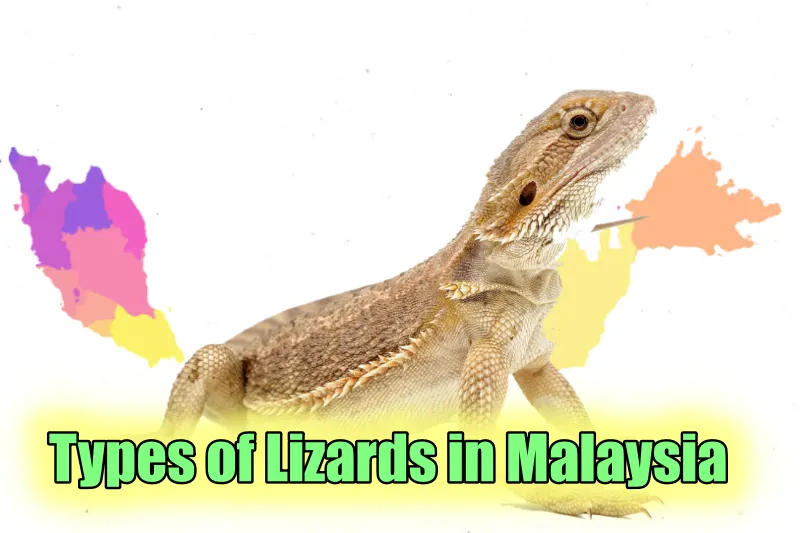[ez-toc]Malaysia is famous for its Petronas Twin Towers, Perhentian Islands, Taman Negara, Mount Kinabalu, and many other cultural beauties; likewise, it is also famous for its animals, especially lizard species. There are a lot more kinds of lizard species found on the land of this group of islands. Moreover, have you ever encountered these lizards in Malaysia? If not, then let’s have a look at the world of lizards in Malaysia.
Note: The reference of this article is malaysia-wildlife-and-nature
Types of Lizards in Malaysia
1. Green crested lizard
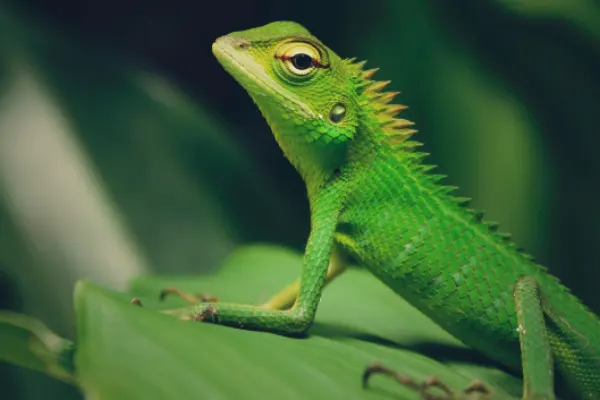
| Scientific name | Bronchocela cristatella |
| Size | Approx. 57 cm |
| Identification | A dark ring around each eye |
The green-crested lizard, also known as Bronchocela cristatella, is a Southeast Asian agamid lizard with a bright green head and sometimes a blue tint. It can change color to a darker brown when threatened.
The lizard has a dark ring around each eye and a dark spot at the back of its head. Males have a crest on the neck and a long, thin tail. The total length is 57 cm (22 in) including the tail.
2. Oriental garden lizards
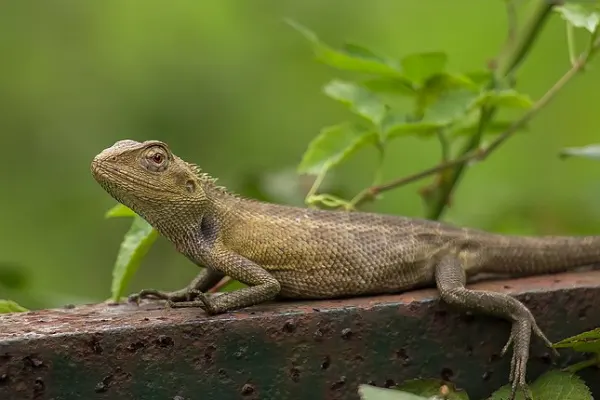
| Scientific name | Calotes versicolor |
| Size | 10-37 cm |
| Identification | yellowish bands across the back |
The oriental garden lizard, also known as the eastern garden lizard, is an agamid lizard found in Indo-Malaya and other parts of the world. It is an insectivore with a bright red throat in the breeding season.
The lizard measures over 10 cm in length, snout-to-vent, and up to 37 cm including the tail. It has two small groups of spines above each tympanum, a moderately elevated dorsal crest, and a series of scales around the middle of the trunk.
The hind foot is longer in the young, while the adult is not much longer than the head. The coloration is variable, with brownish, greyish-olive, or yellowish bands across the back and a yellowish lateral band.
Black streaks radiate from the eye and run obliquely backward over the throat.
3. Common butterfly lizards
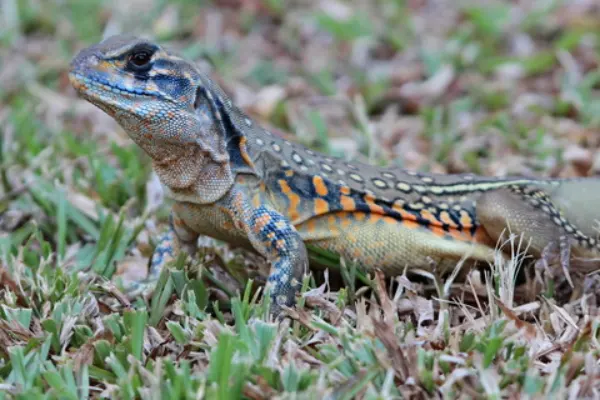
| Scientific name | Leiolepis belli ana |
| Size | Approx. 40 cm |
| Identification | Yellowish spots |
The next one is the common butterfly lizard, which can be easily found in Thailand, Peninsular Malaysia, and Sumatra. Furthermore, these lizards are characterized by their greenish-grey color, yellowish spots, and black and orange markings along their flank.
Juveniles are striped and have a reddish tail. They can be found basking in the sun, along sandy trails, and on golf courses. They return to their burrows at night, possibly as a defensive measure against nocturnal snakes.
4. Emma Gray’s forest lizard
| Scientific name | Calotes emma |
| Size | 28-40 cm |
| Identification | Groups of spines on each side of the head |
Calotes emma, also known as the forest garden lizard or Emma Gray’s forest lizard, is a species of lizard native to China, South Asia, and Southeast Asia.
It has a physical structure consisting of three separate groups of spines on each side of the head, a well-developed dorsal crest, a transverse fold in front of each shoulder, and a laterally compressed tail.
Furthermore, the dorsum is brownish olive, with brown bands across the back, lighter in the middle, and interrupted by a white band. Do you know their eyelids have short brown streaks?
Other than that, the fold before the shoulder is black with an irregular white margin. Also, the legs and tail have indistinct dark crossbands. The species can grow around 28–40 cm.
5. Common gliding lizard
| Scientific name | Draco sumatranus |
| Size | Approx. 9 cm |
| Identification | Long tail |
Draco sumatranus, a common gliding lizard species, is an agamid lizard native to Southeast Asia. Its elongated ribs and skin flaps enable it to glide between tree trunks.
The lizard’s dark gray or brown body, with stripes and patterns, camouflages against tree trunks.
Males have a yellow triangular flap of skin under the chin, called the gular fold, used for mating, while females have a smaller blue flap. Draco sumatranus is found in forests and urban settings like parks and gardens.
6. Chameleon forest dragon
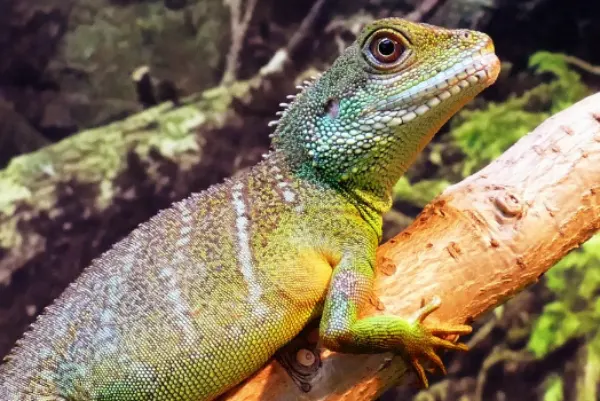
| Scientific name | Gonocephalus chamaeleontinus |
| Size | 22-25 cm |
| Identification | Yellow patches |
Gonocephalus chamaeleontinus, also known as the chameleon forest dragon or chameleon anglehead lizard, is an agamid lizard from Indonesia and Malaysia.
It lives in central Java’s humid tropical forests, measuring 22–25 cm and having a territorial lifestyle similar to chameleons. Females are green, males bluer, and have yellow patches.
7. Blanford’s flying dragon
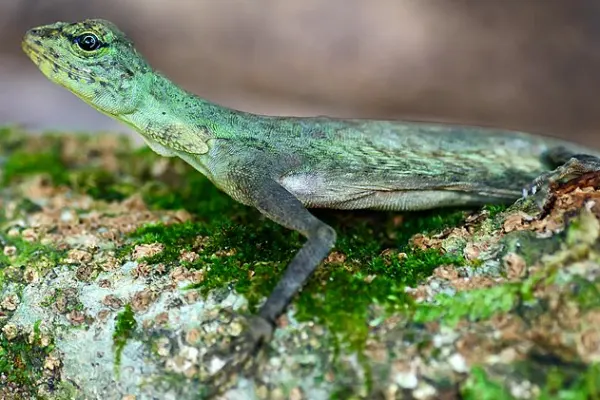
| Scientific name | Draco blanfordii |
| Size | Approx. 38 cm |
| Identification | Small head |
The next species on the list is Blandford’s flying dragon; you can also call it Blandford’s flying lizard or gliding lizard. Scientifically, it is known as Draco blanfordii, which is a flying lizard endemic to Asia.
Talking about its appearance, the lizard’s head is small, constricted, and has a vertical nostril. The male has a thin, covered gular appendage, while the dorsal scales are equal and smooth.
Further, the male has a slight nuchal fold; this is the basic difference between the male and female species. The lizard’s coloration is gray-brown above, with small dark spots.
Also, the wing membranes are marbled with a dark brown color, with lighter spots and lines beneath. The throat is unspotted, greenish, and pale scarlet beneath the lateral wattles.
8. Spotted flying dragon
| Scientific name | Draco maculatus |
| Size | Approx. 22 cm |
| Identification | Irregular dorsal scales |
Draco maculatus, also known as the spotted flying dragon or spotted gliding lizard, is an agamid flying lizard native to Southeast Asia. It can glide from tree to tree and has a small head, snout, and lateral nostrils.
The male has a large gular appendage, and the female has a smaller gular sac. Dorsal scales are irregular and feebly keeled, with large trihedral-keeled distant scales on each side of the back.
The forelimb extends beyond the snout tip, and the adpressed hindlimb extends beyond the elbow. The wing membranes have numerous small, round black spots and a blue spot on each side of the gular appendage.
9. Bell’s Anglehead lizard
| Scientific name | Gonocephalus bellii |
| Size | 38-43 cm |
| Identification | Brown stripes |
Gonocephalus bellii, also known as Bell’s anglehead lizard or Bell’s forest dragon, is a species of lizard native to Southeast Asia and Oceania.
Its color ranges from greenish-grey to brown with deep brown stripes, and its males have a colorful dewlap.
10. Malaysian butterfly lizard
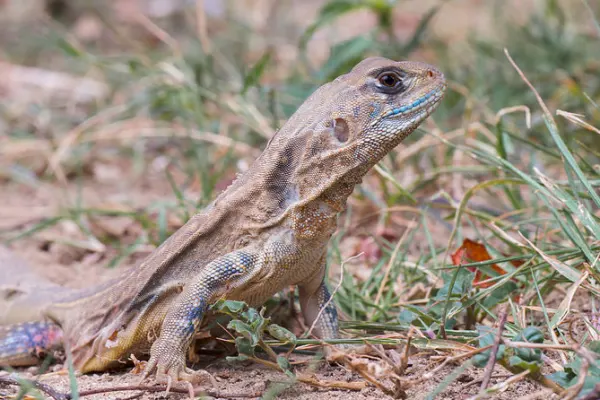
| Scientific name | Leiolepis triploida |
| Size | Up to 40 cm |
| Identification | Pale and brown color spots |
Leiolepis triploida, also known as the Thai butterfly lizard or Malaysian butterfly lizard, is an all-female agamid lizard found in southern Thailand and peninsular Malaysia. Measuring 99–137 mm in snout-vent length, it reproduces asexually and is likely inherited from Leiolepis boehmei, an asexual but diploid species.
11. Abbott’s crested lizard
| Scientific name | Gonocephalus doriae abbotti |
| Size | Approx. 30 cm |
| Identification | small eye opening |
Abbott’s crested lizard, also known as Abbott’s anglehead lizard and Cochran’s forest dragon, is a subspecies of lizard native to Malaysia and Thailand.
It measures 12 inches in total length, including the tail, and features a triangular bony crest on the face and an upturned nose. The dragon’s colors range from tan to green, with olive shades being the most common.
Its structure is compressed and sickle-shaped, with strong, clawed limbs designed for catching prey, digging, and climbing. Its eyesight is exceptional, and its body scales are small.
The tail is strong but not reversible and can break in defense against predators. The crest is complete from head to tail, and the throat pouch is more developed in males.
12. Horned Flying Lizards
| Scientific name | Draco cornutus |
| Size | Around 40 cm |
| Identification | Yellow and black spots |
Draco cornutus is an endemic “flying dragon” lizard found in Borneo, ranging up to 700 meters above sea level.
Its gliding membrane, or patagia, varies with its habitat, and populations have adapted to match the color of local falling leaves, providing camouflage against potential avian predators. However, its distribution is poorly understood.
13. Ornate Earless Agama
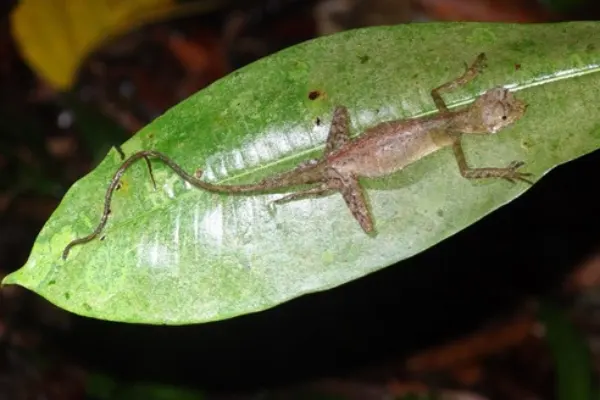
| Scientific name | Aphaniotis ornata |
| Size | approx. 17 cm |
| Identification | Snout at the head |
This description describes a large, conical rostral appendage on the upper part of the head, covering 2.5 mm in small imbricate scales.
It has seven upper and lower labials, a transverse gular fold, an oblique one in front of the shoulder, and a slight nuchal crest. The body is compressed, covered with keeled, unequal scales, and has a slight dorsal crest.
The limbs are very long, especially the hind ones, and the coloration is brownish-red above with small light spots below the eyes.
14. Earless Monitor Lizard
| Scientific name | Lanthanotus borneensis |
| Size | Approx. 40 cm |
| Identification | Short limbs |
The earless monitor lizard is a brown lizard native to Borneo and the only living species in the Lanthanotidae family. It has a cylindrical body, a long neck, short limbs, long, sharp claws, small eyes, semitransparent lower eyelids, and six longitudinal rows of strongly-keeled scales.
Despite lacking a tympanum, it is capable of hearing. The sexes are alike, but males have a broader head and tail base than females.
Adult earless monitor lizards typically have a snout-to-vent length of about 20 cm and a total length of about 40 cm. They can make a gentle, squeaky vocalization.
15. Kuhl’s flying geckos
| Scientific name | Gekko kuhli |
| Size | 15-20 cm |
| Identification | Flattened tail |
Gekko kuhli, also known as Kuhl’s flying gecko, is a Southeast Asian lizard species with unique skin adaptations, including flaps, webbed feet, and a flattened tail.
Its camouflage helps blend with tree bark, and its eyes are the only distinguishing feature.
Due to increased UV exposure, it has evolved pigmented internal organs and intricate toe pads with microscopic hairs to protect its vital organs.
16. A Five-Lined Flying Dragon
| Scientific name | Draco quinquefasciatus |
| Size | Approx. 20 cm |
| Identification | Five black stripes |
The Draco quinquefasciatus lizard, known for its flight capabilities, has evolved over thousands of years to avoid predators on the forest floor.
With elongated ribs that can extend and retract and folds of skin that act as wings when unfurled, Dracos can catch wind and glide. Their long, slender tails allow them to carry up to 30 feet.
Dracos are 8 inches long, mottled brown, with blue and yellow wings. They also have a dewlap, a flap of skin on their necks, which is bright yellow in males and bluish-gray in females.
17. Malaysia Bow-fingered Gecko
| Scientific name | Cyrtodactylus elok |
| Size | Approx. 20 cm |
| Identification | light beige color pattern |
Malaysian bow-finger geckos are medium-sized, slender geckos with interesting patterns and amazing tails. Furthermore, they spend most of their time in branches and have a 2.5–3.5-inch long nose-to-tail tip.
Moreover, their background color changes to lighter beige, yellow, or pink in daylight and darker browns and oranges in the dark. Females can be larger than males.
18. Malayan Crested Lizard
| Scientific name | Bronchocela cristatella |
| Size | Approx. 57 cm |
| Identification | A dark ring around each eye |
Bronchocela cristatella, also known as the green-crested lizard, is an agamid lizard native to Southeast Asia. Do you know this species of lizard in Malaysia is bright green with a blue tint on the head and can change color to brown when threatened?
It has a dark ring around each eye and a dark spot at the back of the head. Males have a crest on the neck and a long, thin tail. The total length is 57 cm.
19. Black rough-necked monitor
| Scientific name | Varanus rudicollis |
| Size | 90-150 cm |
| Identification | Black head |
The black rough-necked monitor, also known as the roughneck monitor, is a species of monitor lizard found in Southeast Asian countries like Thailand, Burma, Malaysia, Indonesia, Sumatra, and the Riau Archipelago.
Further, its habitat is primarily rainforest and mangrove swamps. The black, rough-necked monitor is rarely seen in the wild, possibly due to its secretive behavior.
Talking about the average length, they are medium to large monitors, with an average adult size of 3–4 feet and a maximum length of 5 feet.
They are known for their calm temperament, rarely biting or tail-whipping in captivity, and prefer to escape, urinate, or defecate when threatened.
20. Dumeril’s monitor
| Scientific name | Varanus dumerilii |
| Size | 10-11 cm |
| Identification | Brighter crossbars |
Dumeril’s monitor is a species of lizard in the Varanidae family found in Southeast Asia, including southern Burma, Thailand, Peninsular Malaysia, Singapore, Borneo, Sumatra, Riau, Bangka-Belitung, and smaller Indonesian islands.
Adult monitors are dark brown with brighter crossbars, while juveniles have a dark varnish black color interrupted by yellow crossbars.
The head is shiny orange-red or sometimes yellow, disappearing after 4–8 weeks. Adult monitors can reach up to 4.5 feet in total length, with a typical total length of 4 feet.
21. Cat Gecko
| Scientific name | Aeluroscalabotes felinus |
| Size | Approx. 18 cm |
| Identification | Wide head |
The cat gecko is a species of gecko found in Indonesia, Malaysia, Singapore, Cambodia, and Thailand. It is the only species within the genus Aeluroscalabotes and is known for curling up with its tail when sleeping.
The gecko is light-built, red-brown with white spots, and can grow up to 18 cm (7 inches). It is semi-arboreal, preferring cool, humid, montane rainforest habitats, and is primarily nocturnal and insectivorous, consuming a variety of small insects and arthropods.
22. Malayan forest gecko
| Scientific name | Cyrtodactylus pulchellus |
| Size | Approx. 20 cm |
| Identification | Black and white stripes on the body |
The Malayan forest gecko, also known as the banded bent-toed gecko, is a species of gecko found in Southeast Asia. It has a large, depressed head with a snout longer than its orbit, a concave forehead and loreal region, and a suboval, vertical ear opening.
The body and limbs are elongated, with strong, slightly depressed digits and a basal phalanx with transverse plates.
The head is granular with small round tubercles, while the rostral subquadrangular is nearly twice as broad as deep.
The ventral scales are cycloid and moderately large. Males have a longitudinal groove on the pubic region with 18 to 20 pores on each side.
23. Spotted house gecko
| Scientific name | Gekko monarchus |
| Size | 9-11 cm |
| Identification | Black spots on the back |
Gekko monarchus, also known as the spotted house gecko, is a species of gecko found in the Malay Peninsula, Malaysia, Borneo, the Philippines, Indonesia, and New Guinea. Its body is flat and rough, with small bumps on its back.
Their tails regenerate when dropped, but they never look the same again. Males make quiet clicking sounds when courting a female, while both sexes can chirp and bark. When startled, they wave their tails and may breathe heavily. Monarch geckos have a W spot on their heads.
24. Marbled bow-fingered gecko

| Scientific name | Cyrtodactylus marmoratus |
| Size | Approx. 14 cm |
| Identification | Stripes on the tail |
The marbled bow-fingered gecko is a species of gecko found in Southeast Asia. It has a large, depressed head with a pointed snout, a concave forehead, and an oval, oblique ear opening.
The head is granular, with small tubercles on the occiput and temples, and enlarged on the snout. The rostral subquadrangular is about twice as broad as high, bordered by the first labial and 4 or 5 scales.
The ear opening is oval and oblique, about one-third the diameter of the eye.
The body is elongated, covered above with small granules, and intermixed with small, round, feebly-keeled, subtrihedral tubercles. The ventral scales are small, smooth, and imbricate. The male has 12 or 13 preanal pores and 4-6 femoral pores on each thigh.
25. Clouded monitor
| Scientific name | Varanus nebulosus |
| Size | Approx. 150 cm |
| Identification | white spots on the whole body |
Varanus nebulosus is a medium-sized monitor, reaching 1.5 meters in total length. It has yellow spots on a brown-grey base and is found in diverse habitats like scrubland and rainforest.
It digs among leaf litter for beetles and other insects, and it can climb tree trunks or explore tree holes. This species is rare but can be found in Myanmar, Thailand, Vietnam, Cambodia, Laos, Peninsular Malaysia, Singapore, Java, and Sumatra.
Conclusion:
So these are some of the species of lizards in Malaysia you may find wandering around parks, fields, and other places. If you want to know more about the animal world, then keep looking for it with us on HowItSees.
Reference:
- Wikipedia
- https://www.malaysia-wildlife-and-nature.com/lizards-of-malaysia.html
- A-Z animal
- https://www.ecologyasia.com/verts/lizards/common_butterfly_lizard.htm
- https://reptile-database.reptarium.cz/species?genus=Aphaniotis&species=ornata#:~:text=Body%20compressed%2C%20covered%20with%20keeled,light%20spots%20below%20the%20eyes.
- https://www.nationalgeographic.com/animals/reptiles/facts/draco-lizard#:~:text=They%20have%20flattened%20bodies%2C%20which,and%20bluish%20gray%20in%20females.
- https://www.ecologyasia.com/verts/lizards/clouded_monitor.htm#:~:text=Clouded%20Monitor%20%2D%20Varanus%20nebulosus&text=This%20is%20a%20medium%2Dsized,between%20the%20eye%20and%20snout.
Also Read

As a content writer, I like to write about different niches. I have a curiosity about nature and animals. And like to learn about them. Through my writing, I like to share my experience and knowledge with you. I hope you are enjoying it too.
